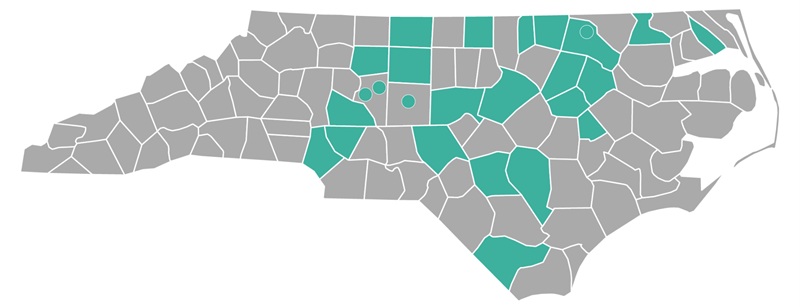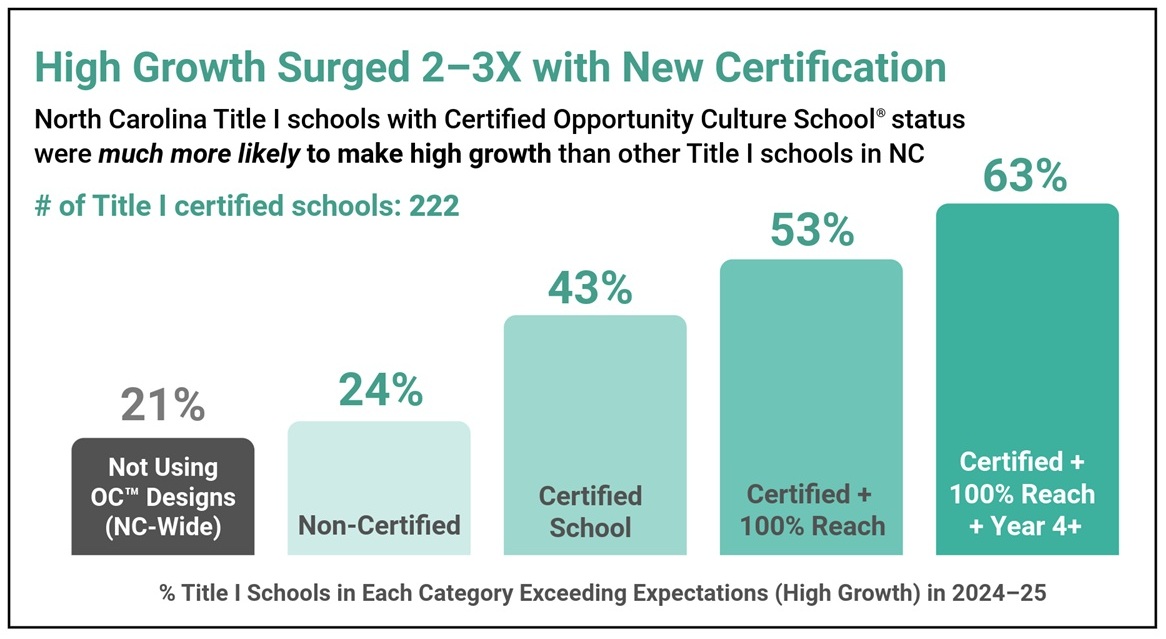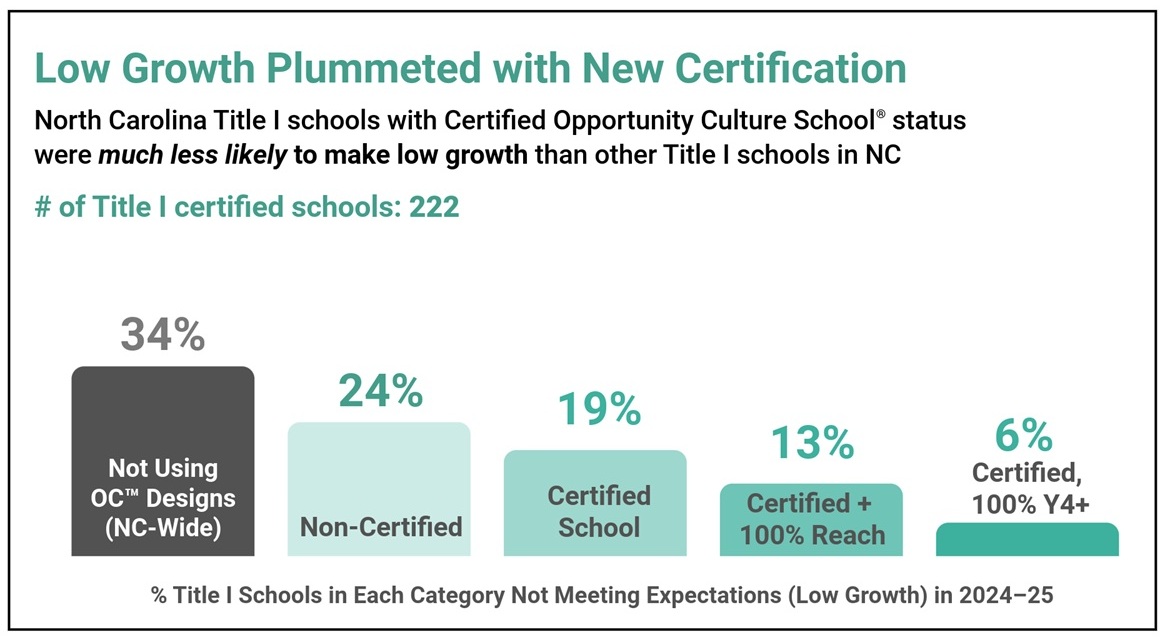
North Carolina schools with Certified Opportunity Culture School® status were two to three times more likely to exceed learning growth expectations than schools not using Opportunity Culture® staffing design, 2024–25 data from the North Carolina Department of Public Instruction shows.
- Of all 258 schools with certification, 48% exceeded growth targets, compared with 25% of all schools in the state without these staffing designs.
- Of the 222 Title I schools with certification, 43% exceeded growth targets, compared with 21% of Title I schools in the state without these designs.
The certified schools were also significantly less likely to fall short of growth expectations than comparable schools.
Opportunity Culture staffing designs extend the reach of excellent teaching to more students, for more pay, within regular budgets. Schools create Multi-Classroom Leader® teaching teams, led by a teacher with a record of high-growth student learning. A team of teachers and administrators at each school determines the exact team design; schools vary significantly in their design, curricula, and instruction.
Schools can receive certification from Public Impact®, which created the Opportunity Culture initiative, by following design standards correlated with high-growth student learning in more than a decade of data. Certified schools also give all instructional staff access to online design materials, which are updated annually.
Although Title I schools using Opportunity Culture designs without certification were also more likely to exceed growth targets and less likely to fall short, the magnitude of differences was far larger for certified schools.
“These results exceeded our expectations and show strong leadership by district and school administrators, educators, and students themselves,” said Bryan C. Hassel, co-president of Public Impact. “This data gives state policymakers who have already shown exceptional leadership even more reason to offer as many schools as possible access to these designs.”
With Experience and Reach, Title I Schools 3X More Likely to Get High Growth
As data suggested in prior years, schools in North Carolina in 2024–25 improved the longer they used Multi-Classroom Leader (MCL™) teams, and the more students they reached with MCL teams.
- When using MCL teams for at least four years and reaching all students in core subjects, 63% of Title I schools with certification had schoolwide high growth—three times the percentage of other Title I schools in the state.
- When reaching all students with MCL teams for any length of time, 53% of Title I schools with certification had schoolwide high growth.


In North Carolina, 89% of schools using MCL teams were Title I in 2022–23, the most recent year of data, compared with about 73 percent of all of the state’s public schools.
In North Carolina, 333 schools in 20 school districts used MCL teams in 2024–25; six more districts began using them in 2025–26. (Schools may receive a provisional level of certification in the planning year, but the comparison figures here include only implementing schools.)
Most of those districts received funding through North Carolina’s Advanced Teaching Roles program to design their staffing plans. Fifteen additional districts have applied to implement Opportunity Culture models but have not yet received funding.
The online design materials are in a portal that includes tools, access to certification, an annual educator survey, and quality monitoring reports at a cost of less than $2 per student annually, on average. Public Impact built this low-cost resource so that states could afford to provide access to all their districts and educators.
Charlotte Schools Show Standout Results
In 2013, Charlotte-Mecklenburg Schools (CMS) became the first district in the country to use Opportunity Culture designs, and will have nearly 180 schools using them this year. In 2024–25, CMS schools with MCL teams were substantially more likely to make high growth and less likely to have low growth than in the prior year, compared with other schools in the state. Approximately 70 percent of certified schools in CMS that had used MCL teams for at least four years exceeded growth targets.
The standout CMS results came after the district committed to certification in late 2024.
“In our current educational climate, the Opportunity Culture model allows schools to recruit, develop and retain exceptional teachers,” Dr. Crystal Hill, superintendent since summer 2023, said last year. “This investment in our teachers ultimately increases the academic performance of our students. Charlotte-Mecklenburg Schools will continue to invest in our schools, teachers and students through our advanced teaching roles programming.”
Nancy Brightwell, CMS chief recruitment, retention and talent development officer, also committed to certification; she leads the district’s Teacher-Leader Pathways team, which supports Opportunity Culture design in the district.
Even when excluding CMS from the data, Title I schools with certified status that reached all students in their fourth year or more of implementation were more than twice as likely to make high growth as other Title I schools in the state, at 50% versus 21%.
More Research on Opportunity Culture Effects on Horizon
Strong results can be seen outside of North Carolina as well. For example, Ector County ISD in Texas, which began using MCL teams in 2020–21, was one of only four large school districts nationally in which reading and math achievement were higher in 2024 than in 2019, according to the Harvard-Stanford Education Recovery Scorecard. Learning growth surged, and teacher vacancies plummeted 90%. Immediate past superintendent Dr. Scott Muri recently testified in Congress about this work.
Public Impact is working to gather a national research team and funding to better understand the direct and spillover instructional effects of Opportunity Culture design, and its effects on talent attraction, retention, and motivation.
“Understanding exactly why the initiative works is important, but reaching students with it faster is urgent,” Co-President Emily Ayscue Hassel said. “Every year of learning and life is precious. The potential economic effects are also enormous.”
How Districts Use Opportunity Culture Models
Each school forms a design and implementation team of teachers and administrators that determines how to use Opportunity Culture roles to reach more students with excellent teaching. The design teams reallocate school budgets to permanently fund pay supplements for those in Opportunity Culture roles, in contrast to temporary grant-funded programs. In addition to these supplements, the Opportunity Culture initiative continues to support higher pay for all teachers, where budgets allow.
The Multi-Classroom Leader (MCL) role is the cornerstone role, for a teacher with a track record of high-growth student learning who leads and supports a small teaching team for a substantial pay supplement, averaging 23 percent of average teacher pay, or $13,513, and as high as $20,000. The supplements are making it possible for some teachers to reach six-figure salaries.
MCL teams may include educators in Team Reach Teacher™ roles, for teachers who directly teach more students—important in schools with teacher shortages—typically without raising instructional group sizes, for more pay. This avoids filling a portion of teacher vacancies with long-term substitutes. MCL-guided tutoring by advanced paraprofessionals in the Reach Associate™ role supports students. Some states have added paid residencies and apprenticeships to these teams.
These roles all receive higher pay that is sustainable through reallocations of regular budgets; each school’s design team determines budget changes.
Anonymous, annual surveys over 10 years show that 97% to 99% of teachers in Multi-Classroom Leader roles want the roles to continue in their schools. For educators in all Opportunity Culture roles, that response has risen steadily to 90% in the most recent survey.
Certified schools attest to meeting design standards associated with higher-growth learning in 12 years of data collected by Public Impact. These schools also give all instructional staff online access to design materials in the Opportunity Culture portal, which are updated annually using new data.
Since 2013, more than 80 sites in 17 states and the District of Columbia have used the models, reaching a projected 225,000 students in 2025–26, with more than 20,000 students added annually in recent years. Since the initiative began, Opportunity Culture educators earned an estimated $100 million in extra pay. See the latest figures on the Opportunity Culture dashboard.
